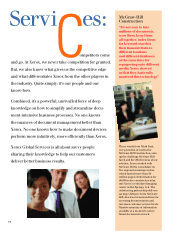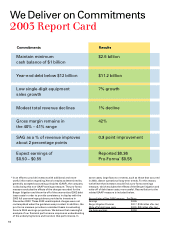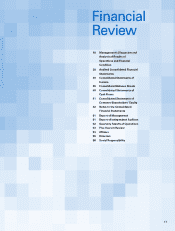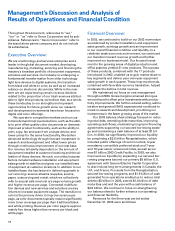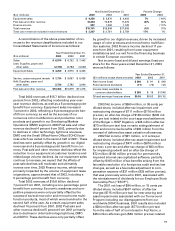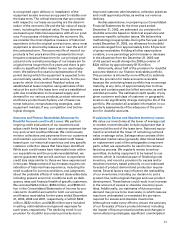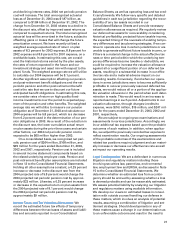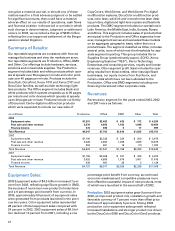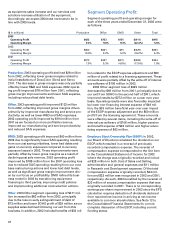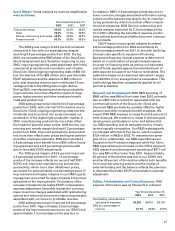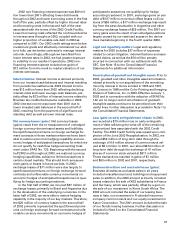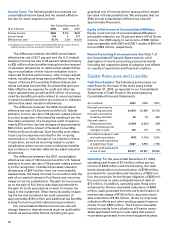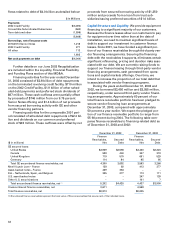Xerox 2003 Annual Report Download - page 25
Download and view the complete annual report
Please find page 25 of the 2003 Xerox annual report below. You can navigate through the pages in the report by either clicking on the pages listed below, or by using the keyword search tool below to find specific information within the annual report.
23
and declining interest rates, 2004 net periodic pension
cost will increase. The total unrecognized actuarial
loss as of December 31, 2003 was $1.87 billion, as
compared to $1.84 billion at December 31, 2002. The
change from December 31, 2002 relates to a decline in
the discount rate, offset by improved asset returns as
compared to expected returns. The total unrecognized
actuarial loss will be amortized in the future, subject to
offsetting gains or losses that will change the future
amortization amount. We have recently utilized a
weighted average expected rate of return on plan
assets of 8.3 percent for 2003 expense, 8.8 percent for
2002 expense and 8.9 percent for 2001 expense, on a
worldwide basis. In estimating this rate, we consid-
ered the historical returns earned by the plan assets,
the rates of return expected in the future and our
investment strategy and asset mix with respect to the
plans’ funds. The weighted average rate we will utilize
to calculate our 2004 expense will be 8.1 percent.
Another significant assumption affecting our pension
and post-retirement benefit obligations and the net
periodic pension and other post-retirement benefit
cost is the rate that we use to discount our future
anticipated benefit obligations. In estimating this rate,
we consider rates of return on high quality fixed-
income investments over the period to expected pay-
ment of the pension and other benefits. The weighted
average rate we will utilize to measure our pension
obligation as of December 31, 2003 and calculate our
2004 expense will be 5.8 percent, which is a decrease
from 6.2 percent used in the determination of our pen-
sion obligations in 2003. As a result of the reduction in
the discount rate, the lower cumulative actual return
on plan assets during the prior three years and certain
other factors, our 2004 net periodic pension cost is
expected to be $65 million higher than 2003.
On a consolidated basis, we recognized net peri-
odic pension cost of $364 million, $168 million, and
$99 million for the years ended December 31, 2003,
2002 and 2001, respectively. Pension cost is included
in several income statement components based on
the related underlying employee costs. Pension and
post-retirement benefit plan assumptions are included
in Note 12 to the Consolidated Financial Statements.
Holding all other assumptions constant, a 0.25 percent
increase or decrease in the discount rate from the
2004 projected rate of 5.8 percent would change the
2004 projected net periodic pension cost by approxi-
mately $23 million. Likewise, a 0.25 percent increase
or decrease in the expected return on plan assets from
the 2004 projected rate of 8.1 percent would change
the 2004 projected net periodic pension cost by
approximately $9 million.
Income Taxes and Tax Valuation Allowances: We
record the estimated future tax effects of temporary
differences between the tax bases of assets and liabili-
ties and amounts reported in our Consolidated
Balance Sheets, as well as operating loss and tax cred-
it carryforwards. We follow very specific and detailed
guidelines in each tax jurisdiction regarding the recov-
erability of any tax assets recorded in our
Consolidated Balance Sheets and provide necessary
valuation allowances as required. We regularly review
our deferred tax assets for recoverability considering
historical profitability, projected future taxable income,
the expected timing of the reversals of existing tempo-
rary differences and tax planning strategies. If we con-
tinue to operate at a loss in certain jurisdictions or are
unable to generate sufficient future taxable income, or
if there is a material change in the actual effective tax
rates or time period within which the underlying tem-
porary differences become taxable or deductible, we
could be required to increase the valuation allowance
against all or a significant portion of our deferred tax
assets, resulting in a substantial increase in our effec-
tive tax rate and a material adverse impact on our
operating results. Conversely, if and when our opera-
tions in some jurisdictions were to become sufficiently
profitable to recover previously reserved deferred tax
assets, we would reduce all or a portion of the applica-
ble valuation allowance in the period when such deter-
mination is made. This would result in an increase to
reported earnings in such period. Adjustments to our
valuation allowance, through charges (credits) to
expense, were $(16) million, $15 million, and $247 mil-
lion for the years ended December 31, 2003, 2002 and
2001, respectively.
We are subject to ongoing tax examinations and
assessments in various jurisdictions. Accordingly, we
incur additional tax expense based upon the probable
outcomes of such matters. In addition, when applica-
ble, we adjust the previously recorded tax expense to
reflect examination results. Our ongoing assessments
of the probable outcomes of the examinations and
related tax positions require judgment and can materi-
ally increase or decrease our effective tax rate as well
as impact our operating results.
Legal Contingencies: We are a defendant in numerous
litigation and regulatory matters including those
involving securities law, patent law, environmental
law, employment law and ERISA, as discussed in Note
15 to the Consolidated Financial Statements. We
determine whether an estimated loss from a contin-
gency should be accrued by assessing whether a loss
is deemed probable and can be reasonably estimated.
We assess potential liability by analyzing our litigation
and regulatory matters using available information.
We develop our views on estimated losses in consul-
tation with outside counsel handling our defense in
these matters, which involves an analysis of potential
results, assuming a combination of litigation and set-
tlement strategies. Should developments in any of
these matters cause a change in our determination as
to an unfavorable outcome and result in the need to



